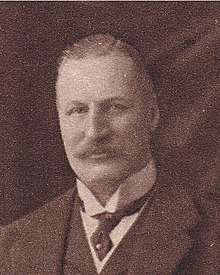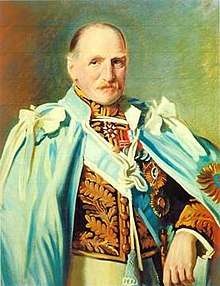George Stanley (British politician)
Sir George Frederick Stanley GCSI GCIE CMG (14 October 1872 – 1 July 1938) was a British soldier and Conservative Party politician who served as a member of the UK Parliament for Preston and later, Willesden East. He also served the Governor of Madras from 1929 to 1934 and as Acting Viceroy of India in 1934.
Sir George Frederick Stanley GCSI GCIE CMG | |
|---|---|
 | |
| Governor of Madras | |
| In office 11 November 1929 – 16 May 1934 | |
| Preceded by | Sir Norman Marjoribanks (acting) |
| Succeeded by | Mohammad Usman of Madras (acting) |
| In office 15 August 1934 – 16 November 1934 | |
| Preceded by | Mohammad Usman of Madras (acting) |
| Succeeded by | John Erskine, Lord Erskine |
| Personal details | |
| Born | 14 October 1872 |
| Died | 1 July 1938 (aged 65) United Kingdom |
| Nationality | British |
| Political party | Conservative |
Life
The sixth son of Frederick Stanley, 16th Earl of Derby, Stanley was educated at Wellington and at Woolwich. In 1903 he married Lady Beatrix Taylour, youngest daughter of the 3rd Marquess of Headfort. He was the grandson of Edward Smith-Stanley, the former British Prime Minister.
He entered the Royal Horse Artillery in 1893 and was promoted to Captain in 1900. He served in the Second Boer War in 1899–1900 and was Adjutant with the Honourable Artillery Company from 1904–1909. He later served in World War I and was mentioned in despatches and awarded the CMG in 1916.
He was Conservative Member of Parliament for Preston from 1910–1922 and for Willesden East from 1924–1929.
He held office as Comptroller of the Household from 1919 until 1921, as Financial Secretary to the War Office from 1921–1922, Parliamentary Under-Secretary of State for the Home Department from 1922–1923, Parliamentary Secretary to the Ministry of Pensions from 1924–1929. He was Governor of Madras from 1929–1934.
He was appointed a Privy Counsellor in 1927 and made a Knight Grand Commander of the Order of the Indian Empire (GCIE) in 1929 and a Knight Grand Commander of the Order of the Star of India in 1934.
As Governor of Madras

Stanley was appointed Governor of Madras on 26 October 1929 at an annual salary of ₹1,20,000.[1] He arrived in India and took over as governor on 12 November 1929.[2]
Stanley assumed the governorate at a critical juncture. The Great Depression had just begun and the economy was deteriorating. The Premier P. Subbarayan resigned after the 1930 elections when his party was voted out. The Swaraj Party boycotted the elections as a part of the Civil Disobedience Movement and the Justice Party was voted to power in the 1930 and 1934 elections. B. Munuswamy Naidu served as Premier from 1930 to 1932 but he had to resign in 1932 due to the strong opposition of landowning elements in the party. Naidu was succeeded by Ramakrishna Ranga Rao of Bobbili whose administration soon became notorious for mis-governance.
During his tenure as governor, Stanley was responsible for implementing the Mettur Dam across the Kaveri River.[3][4][5] The project's inauguration on 21 August 1934, was attended by people from all parts of the Presidency.[3][4] The reservoir created by the Dam was named Stanley Reservoir in his honour. On 17 January 1930, Stanley laid the foundation stone of a Gaudiya Math and a temple at Royapettah, Madras.[6] The first service of the Madras sub-urban line of the South Indian Railway Company was flagged off by Stanley from Chennai Beach railway station on 2 April 1931.[7] In 1933, Stanley inaugurated the five-year medicine and surgery diploma course at the Royapuram Medical College. On 2 July 1938, the school was renamed Stanley Medical College in his honour. In 1931, he had received Ignatius Elias III, the Patriarch of Antioch on his way to Malankara.
Commemoration
The Government Stanley Medical College in Chennai (Madras), Tamil Nadu, India is named in memory of Stanley. The Diploma in Medicine and Surgery program was inaugurated here in 1933 by Stanley when he was the Governor of Madras. The college formerly known as Royapuram Medical School was renamed Stanley Medical School on 27 March 1934 in his honour. It was renamed to Stanley Medical College in 1938.
Notes
- Frederick Martin, Sir John Scott Keltie, Isaac Parker Anderson Renwick, Mortimer Epstein, Sigfrid Henry Steinberg, John Paxton (1933). The Statesman's Yearbook, Volume 20. St. Martin's Press. p. 162.CS1 maint: uses authors parameter (link)
- The India office and Burma office list. India Office. 1931. p. 43.
- Mettur Project, pp 151
- Mettur Project, pp 153
- Mettur Project, pp 479
- Renaissance of Gaudiya Vaishnava movement. Sri Gaudiya Math. 1978. p. 86.
- Muthiah, pp 322
References
- C. G. Barbar, A. Mohanakrishnan (1987). History of the Cauvery-Mettur Project. Central Board of Irrigation & Power.CS1 maint: uses authors parameter (link)
- Muthiah, S. (2004). Madras Rediscovered. East West Books (Madras) Pvt Ltd. ISBN 81-88661-24-4.
External links
- Hansard 1803–2005: contributions in Parliament by George Stanley
| Parliament of the United Kingdom | ||
|---|---|---|
| Preceded by John Thomas Macpherson Harold Cox |
Member of Parliament for Preston January 1910 – 1922 With: Alfred Tobin 1910–1915 Urban H. Broughton 1915–1918 Tom Shaw 1918–1922 |
Succeeded by James Philp Hodge Tom Shaw |
| Preceded by Harcourt Johnstone |
Member of Parliament for Willesden East 1924–1929 |
Succeeded by Daniel Somerville |
| Political offices | ||
| Preceded by Sir Edwin Cornwall |
Comptroller of the Household 1919–1921 |
Succeeded by Harry Barnston |
| Preceded by Sir Norman Marjoribanks |
Governor of Madras 11 November 1929–16 May 1934 |
Succeeded by Mohammad Usman of Madras |